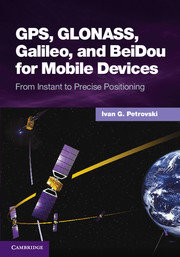Book contents
- Frontmatter
- Contents
- Foreword by Glen Gibbons
- About this book
- Acknowledgments
- List of abbreviations and acronyms
- List of definitions
- Part I GNSS: orbits, signals, and methods
- Part II From conventional to software GNSS receivers and back
- Part III Mobile positioning at present and in the future
- 8 Positioning with data link: from AGPS1 to RTK
- 9 Positioning without data link: from BGPS to PPP
- 10 Trends, opportunities, and prospects
- Part IV Testing mobile devices
- Index
- References
9 - Positioning without data link: from BGPS to PPP
from Part III - Mobile positioning at present and in the future
Published online by Cambridge University Press: 05 May 2014
- Frontmatter
- Contents
- Foreword by Glen Gibbons
- About this book
- Acknowledgments
- List of abbreviations and acronyms
- List of definitions
- Part I GNSS: orbits, signals, and methods
- Part II From conventional to software GNSS receivers and back
- Part III Mobile positioning at present and in the future
- 8 Positioning with data link: from AGPS1 to RTK
- 9 Positioning without data link: from BGPS to PPP
- 10 Trends, opportunities, and prospects
- Part IV Testing mobile devices
- Index
- References
Summary
This chapter is not about standalone positioning as such, but rather about all the enhancements to standalone positioning, which we have discussed in the previous chapter, but achieved without data link. Here we use the term BGPS (BGNSS) to describe technology that achieves results similar to AGPS (AGNSS), but without immediate corrections data.
Advantages of positioning without a data link
In a 1996 article in GPS World magazine [1], the author stated that GPS is calmly but rapidly penetrating mass markets, and finds itself in cellular phones, cars, watches, cameras, and golf carts. By 2013, this process is almost complete. The GNSS is the essential part in all these devices. This has increased the number of GPS users drastically. With the many navigation satellites in the sky, and a handful of GNSS-enabled gadgets, a user would expect to experience a seamless positioning service – instant positioning at any time and at any place. And that is without becoming a specialist in satellite navigation. Technology in general is trying to meet this new requirement, sometimes quite drastically, as in the Windows 8 interface.
- Type
- Chapter
- Information
- GPS, GLONASS, Galileo, and BeiDou for Mobile DevicesFrom Instant to Precise Positioning, pp. 238 - 273Publisher: Cambridge University PressPrint publication year: 2014



